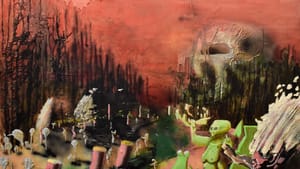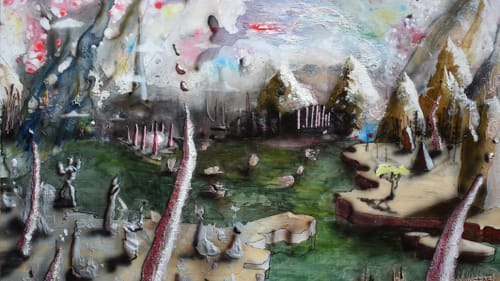Stay in the Loop
BSR publishes on a weekly schedule, with an email newsletter every Wednesday and Thursday morning. There’s no paywall, and subscribing is always free.
In the eye of the beholder
DaVinci Art Alliance presents Orlando Saverino-Loeb's Pareidolic Expanses

The most pressing question about Pareidolic Expanses, an exhibit by Orlando Saverino-Loeb at DaVinci Art Alliance (DVAA), might be, "What exactly is pareidolia?" An unfamiliar term describing a familiar experience, it’s the tendency to interpret vague stimuli as something recognizable.
Humans are predisposed to make sense of what we see and, where external information is lacking, to fill in the spaces with what we think, feel, and believe.
To that end, Saverino-Loeb’s show depicts environments representative enough to put viewers in the frame, but too abstract to tell them where, what, or why. This forces us to draw on our own psyches and imaginations. Three large canvases serve as tickets to the state of pareidolia.
Revealing the internal landscape
There are no horizons, it’s uncertain where light comes from, and vantage points vary. Surroundings are strange, colors misplaced.
Pink arterial stumps rise from a green river in We All Start in the Pink (2018) and the sky is a violent rose, as if on fire. An acid-green being struts in the foreground, looking a lot like the inhabitants of every science fiction movie I’ve seen. Green Being holds up an “arm” insouciantly as if to say, “This is all perfectly normal.”
Pareidolia fully engaged, the viewer tries to play along.
Saverino-Loeb believes interpretations of these works are personal and therefore doesn’t intrude by asking viewers what they think the paintings represent. Though he says the pareidolic works aren’t Rorschach tests, he seems to recognize they have a similar capacity to reveal perceptions.
One thing leads to another
Saverino-Loeb creates the pareidolic works intuitively, without preparatory drawings, adding one mark after another, each influencing the last. At some point, he feels each addition requires a subtraction, the signal that the work is finished.
As the artist lives with a completed work, his perception changes with time. Saverino-Loeb would like viewers to experience the same evolution, if only briefly. While they can’t move into DVAA’s second-floor gallery for an extended stay, the limited size of Pareidolic Expanses enables them to take more time with each painting.

Wandering abstract dreamscapes
Even an extra minute or two can yield discoveries. Wasted Beach (2016) is the acrylic most obviously influenced by Saverino-Loeb’s travel in Italy. Golden light cascades around dark, jagged shapes suggesting a topography created by volcanoes. Daubs of green, brown, and gray appear to be blasted forests and churning water; wind seems to sweep across the scene.
Gaze longer, and new details emerge – a bright band of pink at the edge of the land, a leafless trunk resembling a waving stick figure, and a manatee, flying through the air. Yes, a manatee.
Cheeseman Cometh (2018) could be the cover of a dystopian novel about nuclear winter: icebergs inhabited by towering twisted stalactites float in chemical-green water. A small figure walks at water’s edge, and a single tree stands on the opposite shore.
Background and sky merge into a creamy, post-apocalyptic tableau, fronted by a range of missile-shaped hills. Between two of the peaks, a human face with penetrating eyes peers back at the viewer and smiles ever so slightly. The effect is startling and unsettling. How long has he been there?
Maybe you won’t see a manatee or missiles in the hills, but the Cheeseman? You can’t miss him. The point is, we crave understanding, and a lack of information will not stop us from trying to connect the dots.
It’s fitting that Pareidolic Expanses be exhibited at DVAA, because the institution’s namesake, Leonardo da Vinci, took note of this very phenomenon. DaVinci is quoted on livescience.com as having said, “If you look at any walls spotted with various stains or a mixture of different kinds of stones, if you are about to invent some scene you will be able to see in it a resemblance to various different landscapes adorned with mountains, rivers, rocks, trees, plains, wide valleys, and various groups of hills.”
Leonardo would have definitely seen the manatee.
What, When, Where
Pareidolic Expanses. By Orlando Saverino-Loeb. Through September 12, 2018, at the DaVinci Art Alliance, Gallery Two, 704 Catharine Street, Philadelphia. Reception with the artist August 29, 2018, 6 to 8pm. (215) 550-1446 or davinciartalliance.org.
Sign up for our newsletter
All of the week's new articles, all in one place. Sign up for the free weekly BSR newsletters, and don't miss a conversation.